Economic Analysis of Japan's GDP and Inflation
VerifiedAdded on 2021/04/20
|16
|3358
|70
AI Summary
The provided document is a collection of various sources related to Japan's economic trends from 1953 to 2018. It includes data on GDP, inflation rate, unemployment rate, and exports. The assignment also touches upon the effects of population aging on the Japanese economy, as well as the country's economic power and security. The sources include World Bank data, Trading Economics, and research papers from reputable institutions.
Contribute Materials
Your contribution can guide someone’s learning journey. Share your
documents today.
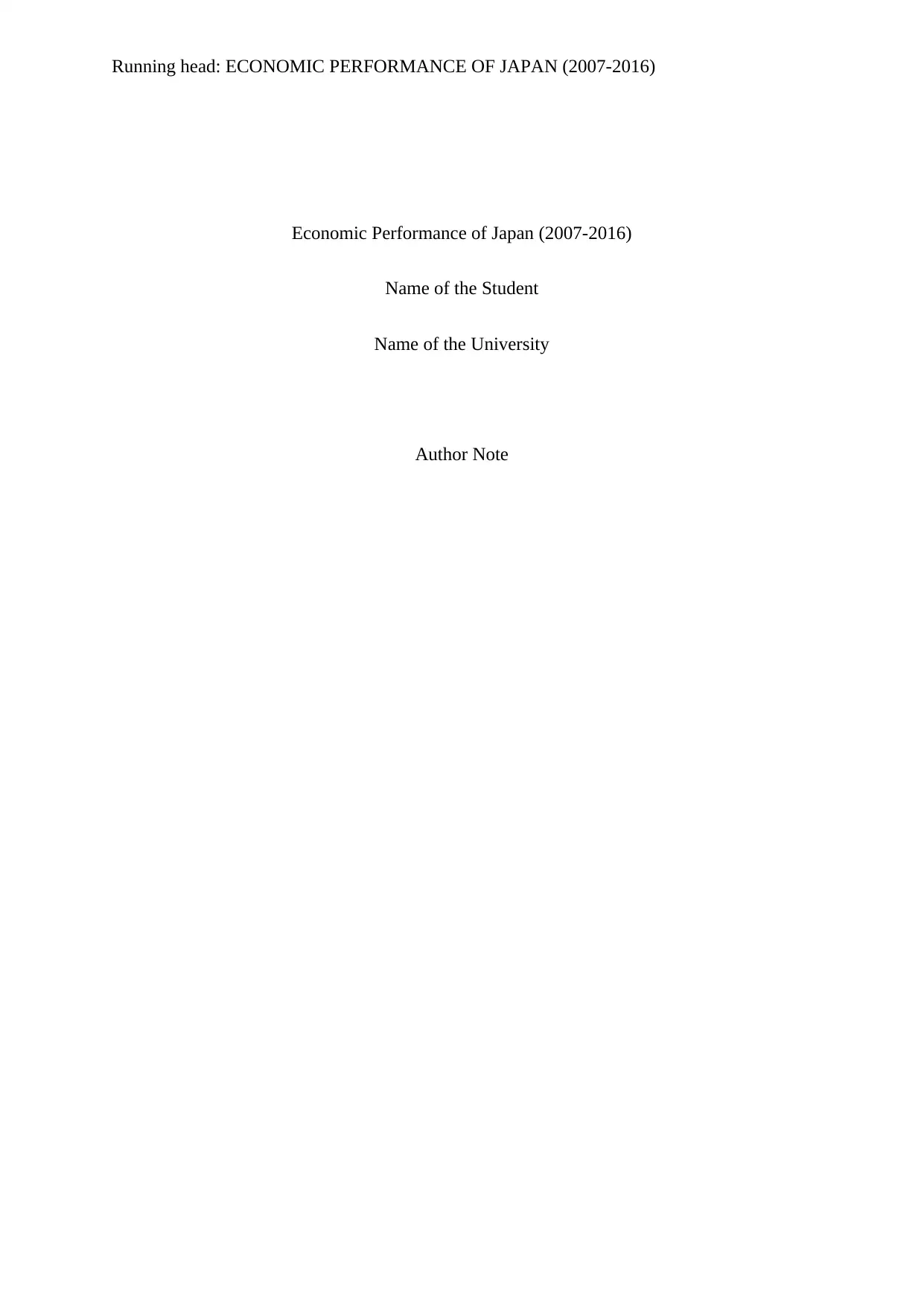
Running head: ECONOMIC PERFORMANCE OF JAPAN (2007-2016)
Economic Performance of Japan (2007-2016)
Name of the Student
Name of the University
Author Note
Economic Performance of Japan (2007-2016)
Name of the Student
Name of the University
Author Note
Secure Best Marks with AI Grader
Need help grading? Try our AI Grader for instant feedback on your assignments.
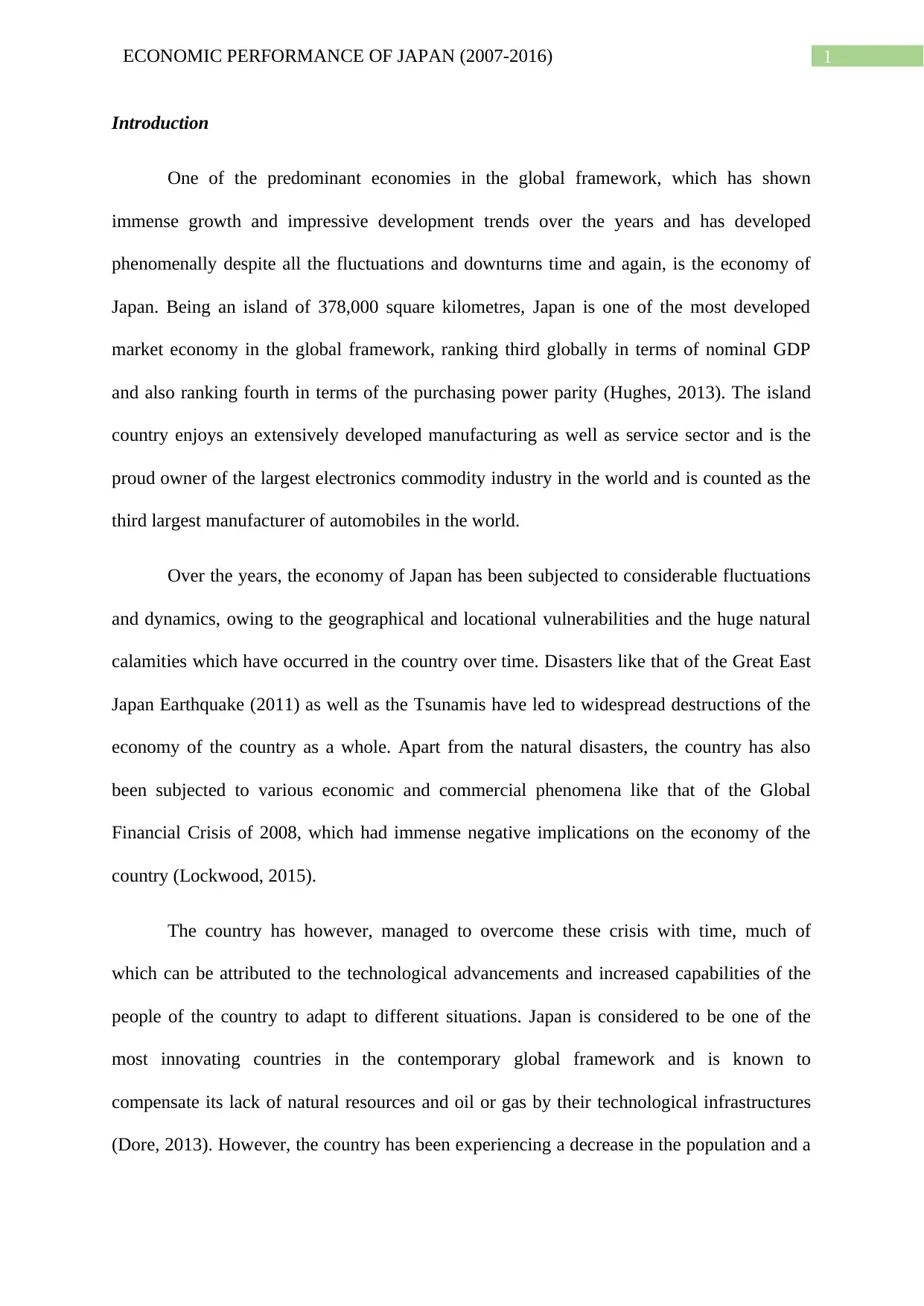
1ECONOMIC PERFORMANCE OF JAPAN (2007-2016)
Introduction
One of the predominant economies in the global framework, which has shown
immense growth and impressive development trends over the years and has developed
phenomenally despite all the fluctuations and downturns time and again, is the economy of
Japan. Being an island of 378,000 square kilometres, Japan is one of the most developed
market economy in the global framework, ranking third globally in terms of nominal GDP
and also ranking fourth in terms of the purchasing power parity (Hughes, 2013). The island
country enjoys an extensively developed manufacturing as well as service sector and is the
proud owner of the largest electronics commodity industry in the world and is counted as the
third largest manufacturer of automobiles in the world.
Over the years, the economy of Japan has been subjected to considerable fluctuations
and dynamics, owing to the geographical and locational vulnerabilities and the huge natural
calamities which have occurred in the country over time. Disasters like that of the Great East
Japan Earthquake (2011) as well as the Tsunamis have led to widespread destructions of the
economy of the country as a whole. Apart from the natural disasters, the country has also
been subjected to various economic and commercial phenomena like that of the Global
Financial Crisis of 2008, which had immense negative implications on the economy of the
country (Lockwood, 2015).
The country has however, managed to overcome these crisis with time, much of
which can be attributed to the technological advancements and increased capabilities of the
people of the country to adapt to different situations. Japan is considered to be one of the
most innovating countries in the contemporary global framework and is known to
compensate its lack of natural resources and oil or gas by their technological infrastructures
(Dore, 2013). However, the country has been experiencing a decrease in the population and a
Introduction
One of the predominant economies in the global framework, which has shown
immense growth and impressive development trends over the years and has developed
phenomenally despite all the fluctuations and downturns time and again, is the economy of
Japan. Being an island of 378,000 square kilometres, Japan is one of the most developed
market economy in the global framework, ranking third globally in terms of nominal GDP
and also ranking fourth in terms of the purchasing power parity (Hughes, 2013). The island
country enjoys an extensively developed manufacturing as well as service sector and is the
proud owner of the largest electronics commodity industry in the world and is counted as the
third largest manufacturer of automobiles in the world.
Over the years, the economy of Japan has been subjected to considerable fluctuations
and dynamics, owing to the geographical and locational vulnerabilities and the huge natural
calamities which have occurred in the country over time. Disasters like that of the Great East
Japan Earthquake (2011) as well as the Tsunamis have led to widespread destructions of the
economy of the country as a whole. Apart from the natural disasters, the country has also
been subjected to various economic and commercial phenomena like that of the Global
Financial Crisis of 2008, which had immense negative implications on the economy of the
country (Lockwood, 2015).
The country has however, managed to overcome these crisis with time, much of
which can be attributed to the technological advancements and increased capabilities of the
people of the country to adapt to different situations. Japan is considered to be one of the
most innovating countries in the contemporary global framework and is known to
compensate its lack of natural resources and oil or gas by their technological infrastructures
(Dore, 2013). However, the country has been experiencing a decrease in the population and a
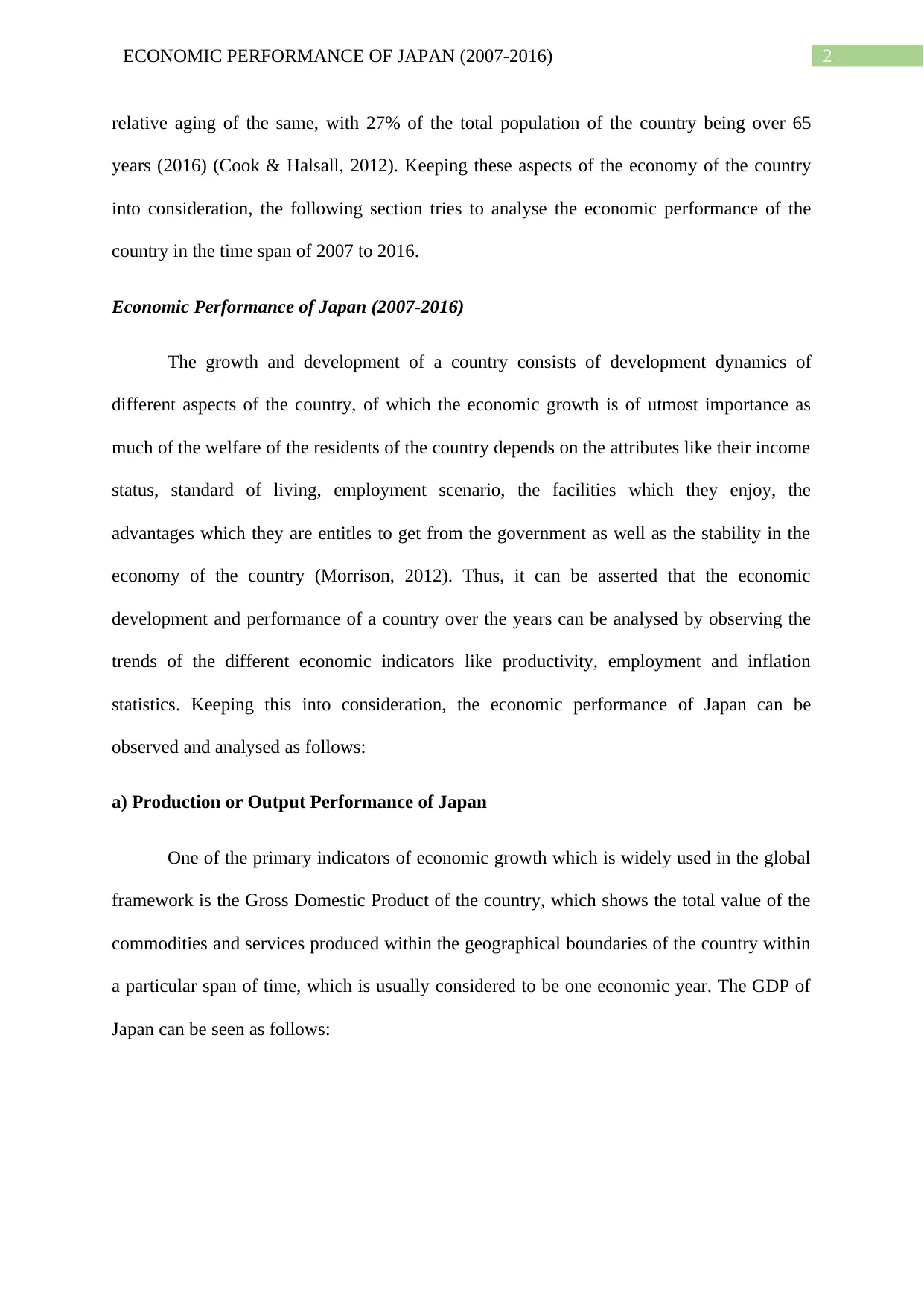
2ECONOMIC PERFORMANCE OF JAPAN (2007-2016)
relative aging of the same, with 27% of the total population of the country being over 65
years (2016) (Cook & Halsall, 2012). Keeping these aspects of the economy of the country
into consideration, the following section tries to analyse the economic performance of the
country in the time span of 2007 to 2016.
Economic Performance of Japan (2007-2016)
The growth and development of a country consists of development dynamics of
different aspects of the country, of which the economic growth is of utmost importance as
much of the welfare of the residents of the country depends on the attributes like their income
status, standard of living, employment scenario, the facilities which they enjoy, the
advantages which they are entitles to get from the government as well as the stability in the
economy of the country (Morrison, 2012). Thus, it can be asserted that the economic
development and performance of a country over the years can be analysed by observing the
trends of the different economic indicators like productivity, employment and inflation
statistics. Keeping this into consideration, the economic performance of Japan can be
observed and analysed as follows:
a) Production or Output Performance of Japan
One of the primary indicators of economic growth which is widely used in the global
framework is the Gross Domestic Product of the country, which shows the total value of the
commodities and services produced within the geographical boundaries of the country within
a particular span of time, which is usually considered to be one economic year. The GDP of
Japan can be seen as follows:
relative aging of the same, with 27% of the total population of the country being over 65
years (2016) (Cook & Halsall, 2012). Keeping these aspects of the economy of the country
into consideration, the following section tries to analyse the economic performance of the
country in the time span of 2007 to 2016.
Economic Performance of Japan (2007-2016)
The growth and development of a country consists of development dynamics of
different aspects of the country, of which the economic growth is of utmost importance as
much of the welfare of the residents of the country depends on the attributes like their income
status, standard of living, employment scenario, the facilities which they enjoy, the
advantages which they are entitles to get from the government as well as the stability in the
economy of the country (Morrison, 2012). Thus, it can be asserted that the economic
development and performance of a country over the years can be analysed by observing the
trends of the different economic indicators like productivity, employment and inflation
statistics. Keeping this into consideration, the economic performance of Japan can be
observed and analysed as follows:
a) Production or Output Performance of Japan
One of the primary indicators of economic growth which is widely used in the global
framework is the Gross Domestic Product of the country, which shows the total value of the
commodities and services produced within the geographical boundaries of the country within
a particular span of time, which is usually considered to be one economic year. The GDP of
Japan can be seen as follows:
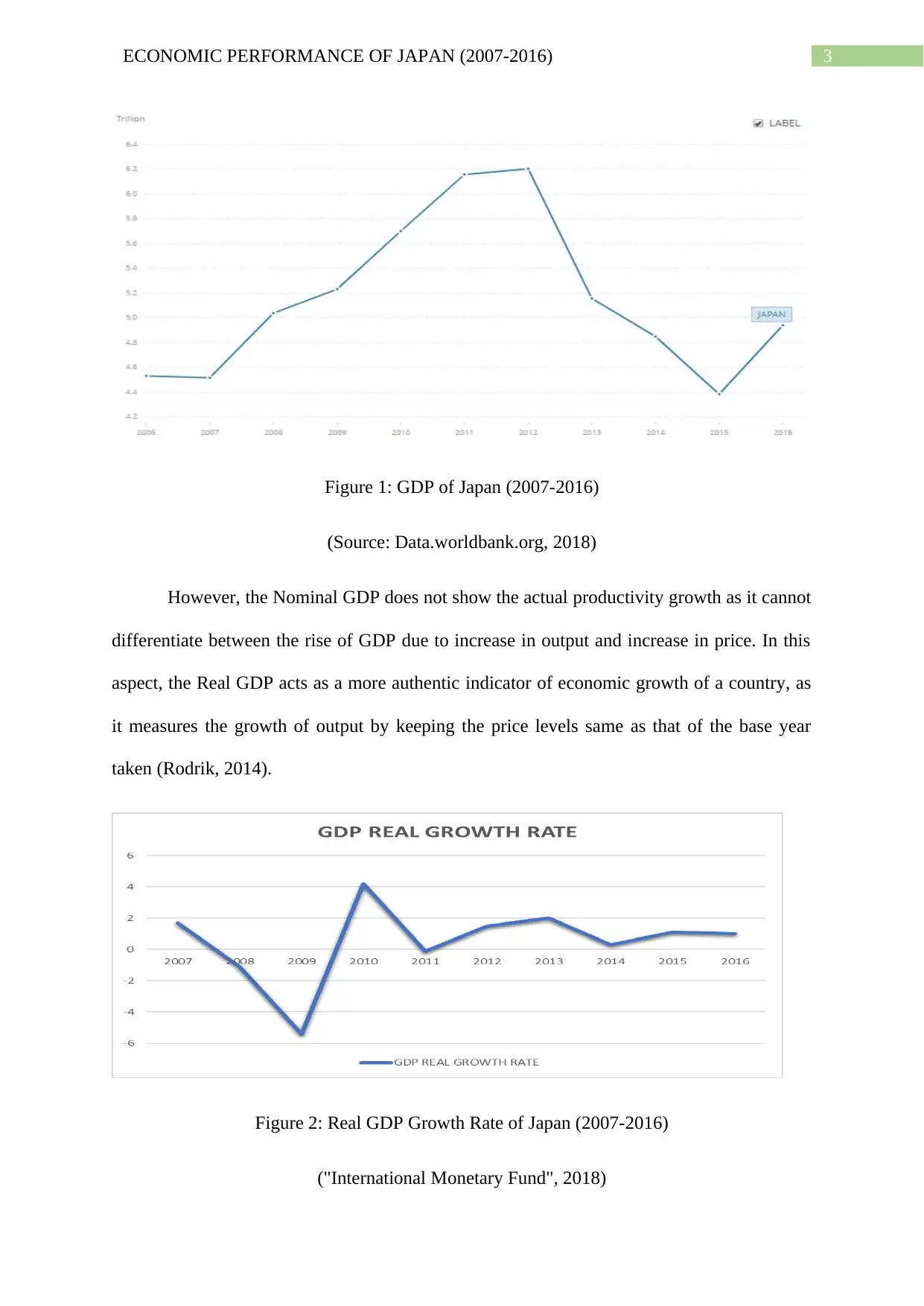
3ECONOMIC PERFORMANCE OF JAPAN (2007-2016)
Figure 1: GDP of Japan (2007-2016)
(Source: Data.worldbank.org, 2018)
However, the Nominal GDP does not show the actual productivity growth as it cannot
differentiate between the rise of GDP due to increase in output and increase in price. In this
aspect, the Real GDP acts as a more authentic indicator of economic growth of a country, as
it measures the growth of output by keeping the price levels same as that of the base year
taken (Rodrik, 2014).
Figure 2: Real GDP Growth Rate of Japan (2007-2016)
("International Monetary Fund", 2018)
Figure 1: GDP of Japan (2007-2016)
(Source: Data.worldbank.org, 2018)
However, the Nominal GDP does not show the actual productivity growth as it cannot
differentiate between the rise of GDP due to increase in output and increase in price. In this
aspect, the Real GDP acts as a more authentic indicator of economic growth of a country, as
it measures the growth of output by keeping the price levels same as that of the base year
taken (Rodrik, 2014).
Figure 2: Real GDP Growth Rate of Japan (2007-2016)
("International Monetary Fund", 2018)
Secure Best Marks with AI Grader
Need help grading? Try our AI Grader for instant feedback on your assignments.
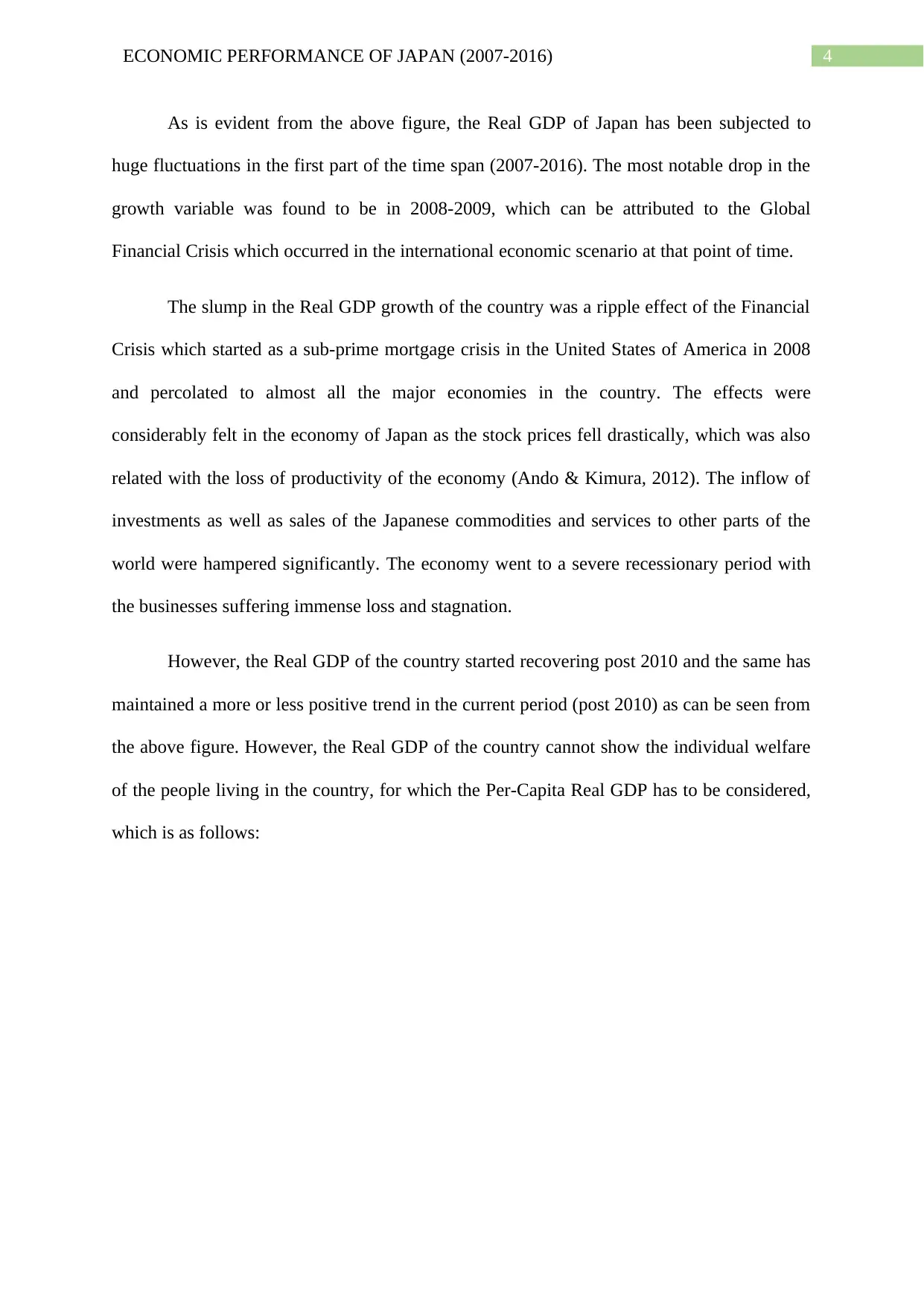
4ECONOMIC PERFORMANCE OF JAPAN (2007-2016)
As is evident from the above figure, the Real GDP of Japan has been subjected to
huge fluctuations in the first part of the time span (2007-2016). The most notable drop in the
growth variable was found to be in 2008-2009, which can be attributed to the Global
Financial Crisis which occurred in the international economic scenario at that point of time.
The slump in the Real GDP growth of the country was a ripple effect of the Financial
Crisis which started as a sub-prime mortgage crisis in the United States of America in 2008
and percolated to almost all the major economies in the country. The effects were
considerably felt in the economy of Japan as the stock prices fell drastically, which was also
related with the loss of productivity of the economy (Ando & Kimura, 2012). The inflow of
investments as well as sales of the Japanese commodities and services to other parts of the
world were hampered significantly. The economy went to a severe recessionary period with
the businesses suffering immense loss and stagnation.
However, the Real GDP of the country started recovering post 2010 and the same has
maintained a more or less positive trend in the current period (post 2010) as can be seen from
the above figure. However, the Real GDP of the country cannot show the individual welfare
of the people living in the country, for which the Per-Capita Real GDP has to be considered,
which is as follows:
As is evident from the above figure, the Real GDP of Japan has been subjected to
huge fluctuations in the first part of the time span (2007-2016). The most notable drop in the
growth variable was found to be in 2008-2009, which can be attributed to the Global
Financial Crisis which occurred in the international economic scenario at that point of time.
The slump in the Real GDP growth of the country was a ripple effect of the Financial
Crisis which started as a sub-prime mortgage crisis in the United States of America in 2008
and percolated to almost all the major economies in the country. The effects were
considerably felt in the economy of Japan as the stock prices fell drastically, which was also
related with the loss of productivity of the economy (Ando & Kimura, 2012). The inflow of
investments as well as sales of the Japanese commodities and services to other parts of the
world were hampered significantly. The economy went to a severe recessionary period with
the businesses suffering immense loss and stagnation.
However, the Real GDP of the country started recovering post 2010 and the same has
maintained a more or less positive trend in the current period (post 2010) as can be seen from
the above figure. However, the Real GDP of the country cannot show the individual welfare
of the people living in the country, for which the Per-Capita Real GDP has to be considered,
which is as follows:
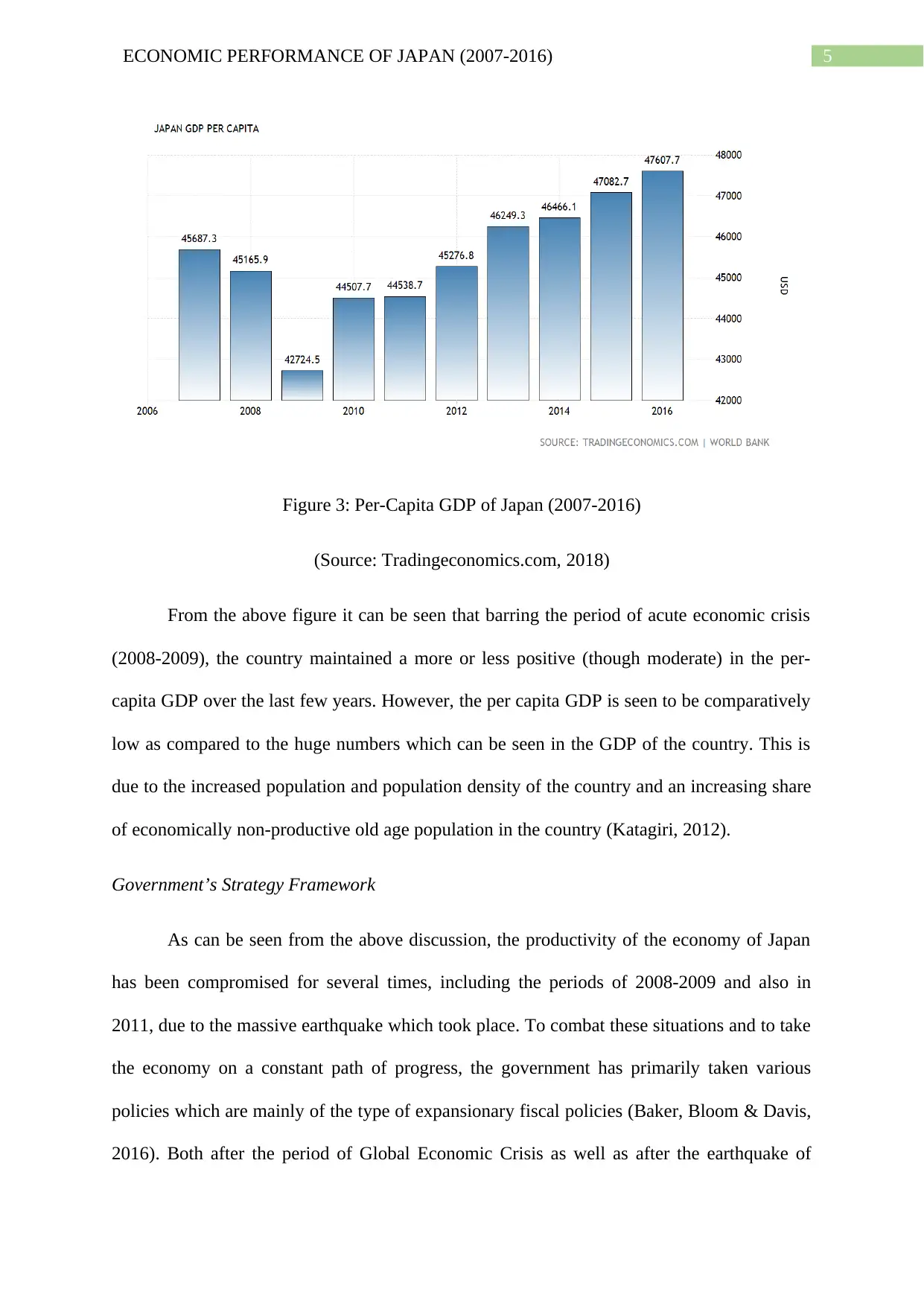
5ECONOMIC PERFORMANCE OF JAPAN (2007-2016)
Figure 3: Per-Capita GDP of Japan (2007-2016)
(Source: Tradingeconomics.com, 2018)
From the above figure it can be seen that barring the period of acute economic crisis
(2008-2009), the country maintained a more or less positive (though moderate) in the per-
capita GDP over the last few years. However, the per capita GDP is seen to be comparatively
low as compared to the huge numbers which can be seen in the GDP of the country. This is
due to the increased population and population density of the country and an increasing share
of economically non-productive old age population in the country (Katagiri, 2012).
Government’s Strategy Framework
As can be seen from the above discussion, the productivity of the economy of Japan
has been compromised for several times, including the periods of 2008-2009 and also in
2011, due to the massive earthquake which took place. To combat these situations and to take
the economy on a constant path of progress, the government has primarily taken various
policies which are mainly of the type of expansionary fiscal policies (Baker, Bloom & Davis,
2016). Both after the period of Global Economic Crisis as well as after the earthquake of
Figure 3: Per-Capita GDP of Japan (2007-2016)
(Source: Tradingeconomics.com, 2018)
From the above figure it can be seen that barring the period of acute economic crisis
(2008-2009), the country maintained a more or less positive (though moderate) in the per-
capita GDP over the last few years. However, the per capita GDP is seen to be comparatively
low as compared to the huge numbers which can be seen in the GDP of the country. This is
due to the increased population and population density of the country and an increasing share
of economically non-productive old age population in the country (Katagiri, 2012).
Government’s Strategy Framework
As can be seen from the above discussion, the productivity of the economy of Japan
has been compromised for several times, including the periods of 2008-2009 and also in
2011, due to the massive earthquake which took place. To combat these situations and to take
the economy on a constant path of progress, the government has primarily taken various
policies which are mainly of the type of expansionary fiscal policies (Baker, Bloom & Davis,
2016). Both after the period of Global Economic Crisis as well as after the earthquake of
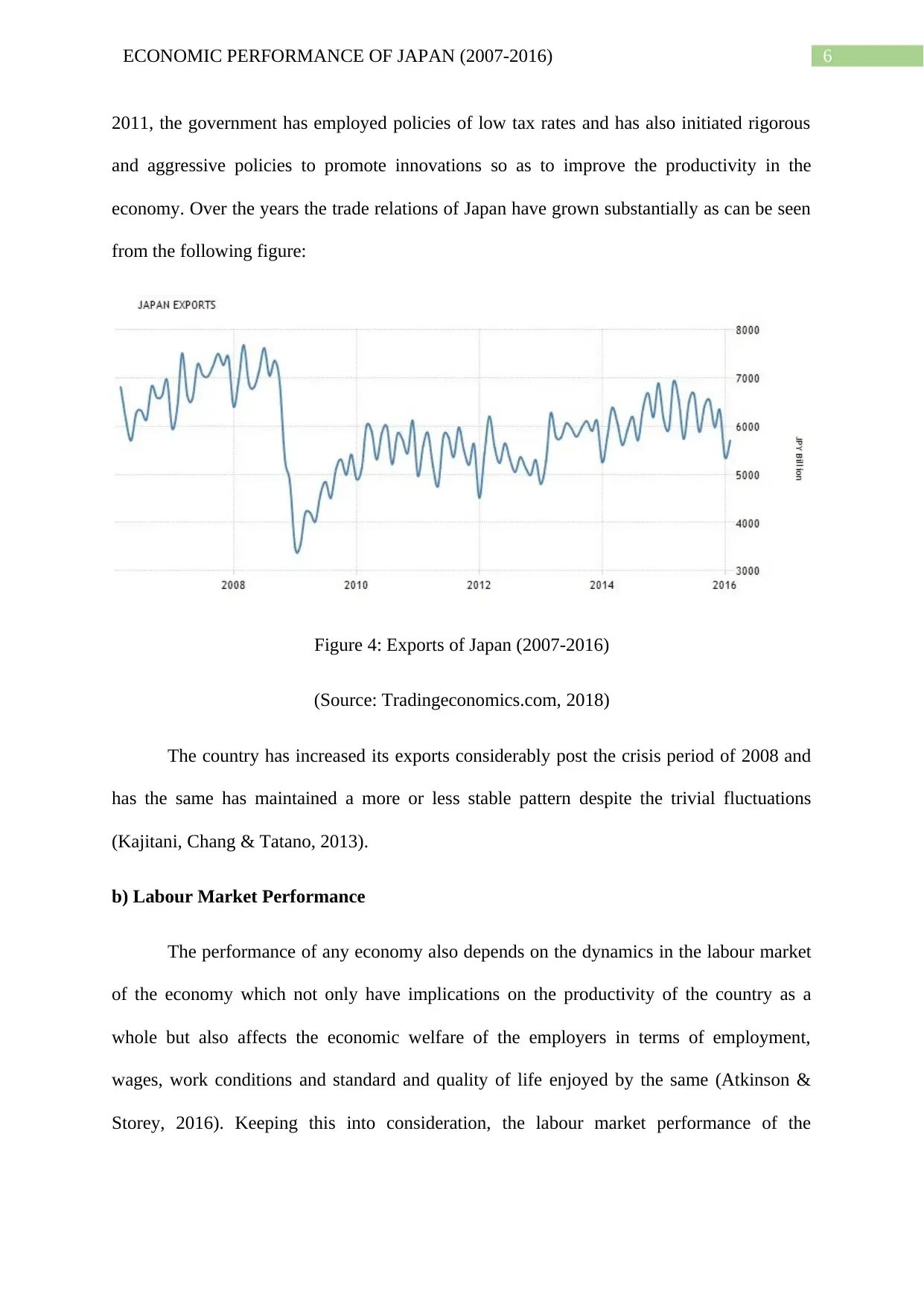
6ECONOMIC PERFORMANCE OF JAPAN (2007-2016)
2011, the government has employed policies of low tax rates and has also initiated rigorous
and aggressive policies to promote innovations so as to improve the productivity in the
economy. Over the years the trade relations of Japan have grown substantially as can be seen
from the following figure:
Figure 4: Exports of Japan (2007-2016)
(Source: Tradingeconomics.com, 2018)
The country has increased its exports considerably post the crisis period of 2008 and
has the same has maintained a more or less stable pattern despite the trivial fluctuations
(Kajitani, Chang & Tatano, 2013).
b) Labour Market Performance
The performance of any economy also depends on the dynamics in the labour market
of the economy which not only have implications on the productivity of the country as a
whole but also affects the economic welfare of the employers in terms of employment,
wages, work conditions and standard and quality of life enjoyed by the same (Atkinson &
Storey, 2016). Keeping this into consideration, the labour market performance of the
2011, the government has employed policies of low tax rates and has also initiated rigorous
and aggressive policies to promote innovations so as to improve the productivity in the
economy. Over the years the trade relations of Japan have grown substantially as can be seen
from the following figure:
Figure 4: Exports of Japan (2007-2016)
(Source: Tradingeconomics.com, 2018)
The country has increased its exports considerably post the crisis period of 2008 and
has the same has maintained a more or less stable pattern despite the trivial fluctuations
(Kajitani, Chang & Tatano, 2013).
b) Labour Market Performance
The performance of any economy also depends on the dynamics in the labour market
of the economy which not only have implications on the productivity of the country as a
whole but also affects the economic welfare of the employers in terms of employment,
wages, work conditions and standard and quality of life enjoyed by the same (Atkinson &
Storey, 2016). Keeping this into consideration, the labour market performance of the
Paraphrase This Document
Need a fresh take? Get an instant paraphrase of this document with our AI Paraphraser
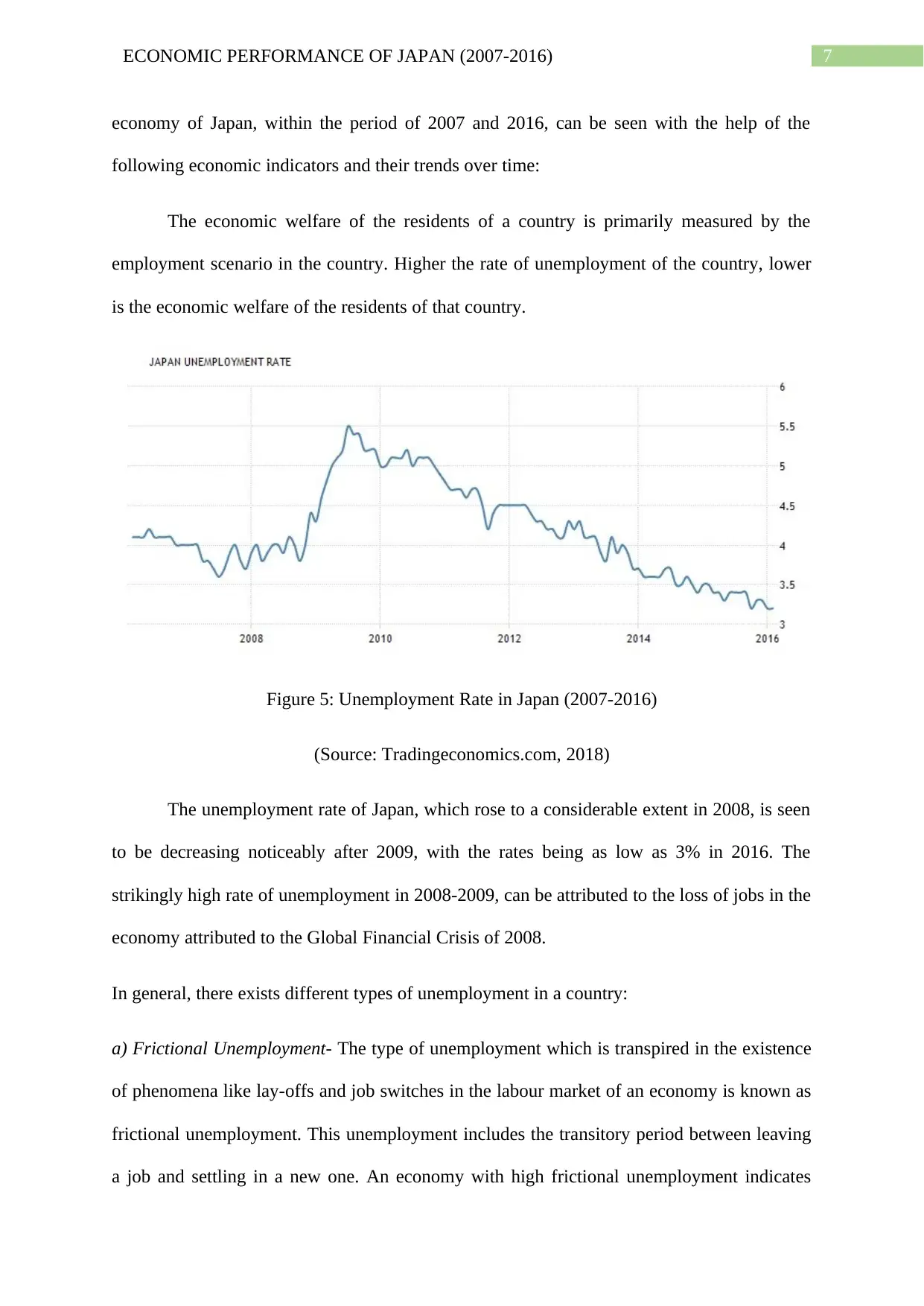
7ECONOMIC PERFORMANCE OF JAPAN (2007-2016)
economy of Japan, within the period of 2007 and 2016, can be seen with the help of the
following economic indicators and their trends over time:
The economic welfare of the residents of a country is primarily measured by the
employment scenario in the country. Higher the rate of unemployment of the country, lower
is the economic welfare of the residents of that country.
Figure 5: Unemployment Rate in Japan (2007-2016)
(Source: Tradingeconomics.com, 2018)
The unemployment rate of Japan, which rose to a considerable extent in 2008, is seen
to be decreasing noticeably after 2009, with the rates being as low as 3% in 2016. The
strikingly high rate of unemployment in 2008-2009, can be attributed to the loss of jobs in the
economy attributed to the Global Financial Crisis of 2008.
In general, there exists different types of unemployment in a country:
a) Frictional Unemployment- The type of unemployment which is transpired in the existence
of phenomena like lay-offs and job switches in the labour market of an economy is known as
frictional unemployment. This unemployment includes the transitory period between leaving
a job and settling in a new one. An economy with high frictional unemployment indicates
economy of Japan, within the period of 2007 and 2016, can be seen with the help of the
following economic indicators and their trends over time:
The economic welfare of the residents of a country is primarily measured by the
employment scenario in the country. Higher the rate of unemployment of the country, lower
is the economic welfare of the residents of that country.
Figure 5: Unemployment Rate in Japan (2007-2016)
(Source: Tradingeconomics.com, 2018)
The unemployment rate of Japan, which rose to a considerable extent in 2008, is seen
to be decreasing noticeably after 2009, with the rates being as low as 3% in 2016. The
strikingly high rate of unemployment in 2008-2009, can be attributed to the loss of jobs in the
economy attributed to the Global Financial Crisis of 2008.
In general, there exists different types of unemployment in a country:
a) Frictional Unemployment- The type of unemployment which is transpired in the existence
of phenomena like lay-offs and job switches in the labour market of an economy is known as
frictional unemployment. This unemployment includes the transitory period between leaving
a job and settling in a new one. An economy with high frictional unemployment indicates
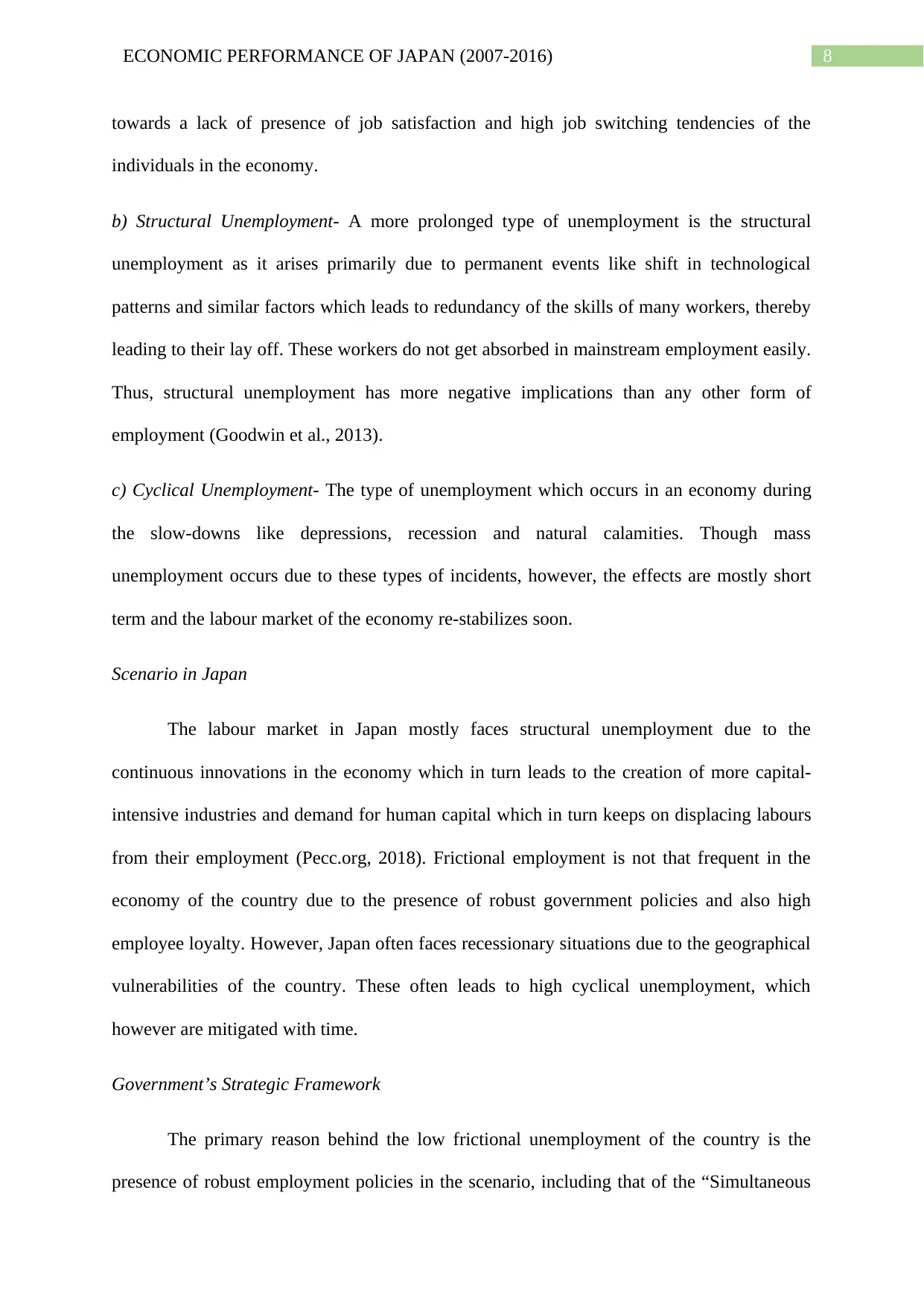
8ECONOMIC PERFORMANCE OF JAPAN (2007-2016)
towards a lack of presence of job satisfaction and high job switching tendencies of the
individuals in the economy.
b) Structural Unemployment- A more prolonged type of unemployment is the structural
unemployment as it arises primarily due to permanent events like shift in technological
patterns and similar factors which leads to redundancy of the skills of many workers, thereby
leading to their lay off. These workers do not get absorbed in mainstream employment easily.
Thus, structural unemployment has more negative implications than any other form of
employment (Goodwin et al., 2013).
c) Cyclical Unemployment- The type of unemployment which occurs in an economy during
the slow-downs like depressions, recession and natural calamities. Though mass
unemployment occurs due to these types of incidents, however, the effects are mostly short
term and the labour market of the economy re-stabilizes soon.
Scenario in Japan
The labour market in Japan mostly faces structural unemployment due to the
continuous innovations in the economy which in turn leads to the creation of more capital-
intensive industries and demand for human capital which in turn keeps on displacing labours
from their employment (Pecc.org, 2018). Frictional employment is not that frequent in the
economy of the country due to the presence of robust government policies and also high
employee loyalty. However, Japan often faces recessionary situations due to the geographical
vulnerabilities of the country. These often leads to high cyclical unemployment, which
however are mitigated with time.
Government’s Strategic Framework
The primary reason behind the low frictional unemployment of the country is the
presence of robust employment policies in the scenario, including that of the “Simultaneous
towards a lack of presence of job satisfaction and high job switching tendencies of the
individuals in the economy.
b) Structural Unemployment- A more prolonged type of unemployment is the structural
unemployment as it arises primarily due to permanent events like shift in technological
patterns and similar factors which leads to redundancy of the skills of many workers, thereby
leading to their lay off. These workers do not get absorbed in mainstream employment easily.
Thus, structural unemployment has more negative implications than any other form of
employment (Goodwin et al., 2013).
c) Cyclical Unemployment- The type of unemployment which occurs in an economy during
the slow-downs like depressions, recession and natural calamities. Though mass
unemployment occurs due to these types of incidents, however, the effects are mostly short
term and the labour market of the economy re-stabilizes soon.
Scenario in Japan
The labour market in Japan mostly faces structural unemployment due to the
continuous innovations in the economy which in turn leads to the creation of more capital-
intensive industries and demand for human capital which in turn keeps on displacing labours
from their employment (Pecc.org, 2018). Frictional employment is not that frequent in the
economy of the country due to the presence of robust government policies and also high
employee loyalty. However, Japan often faces recessionary situations due to the geographical
vulnerabilities of the country. These often leads to high cyclical unemployment, which
however are mitigated with time.
Government’s Strategic Framework
The primary reason behind the low frictional unemployment of the country is the
presence of robust employment policies in the scenario, including that of the “Simultaneous
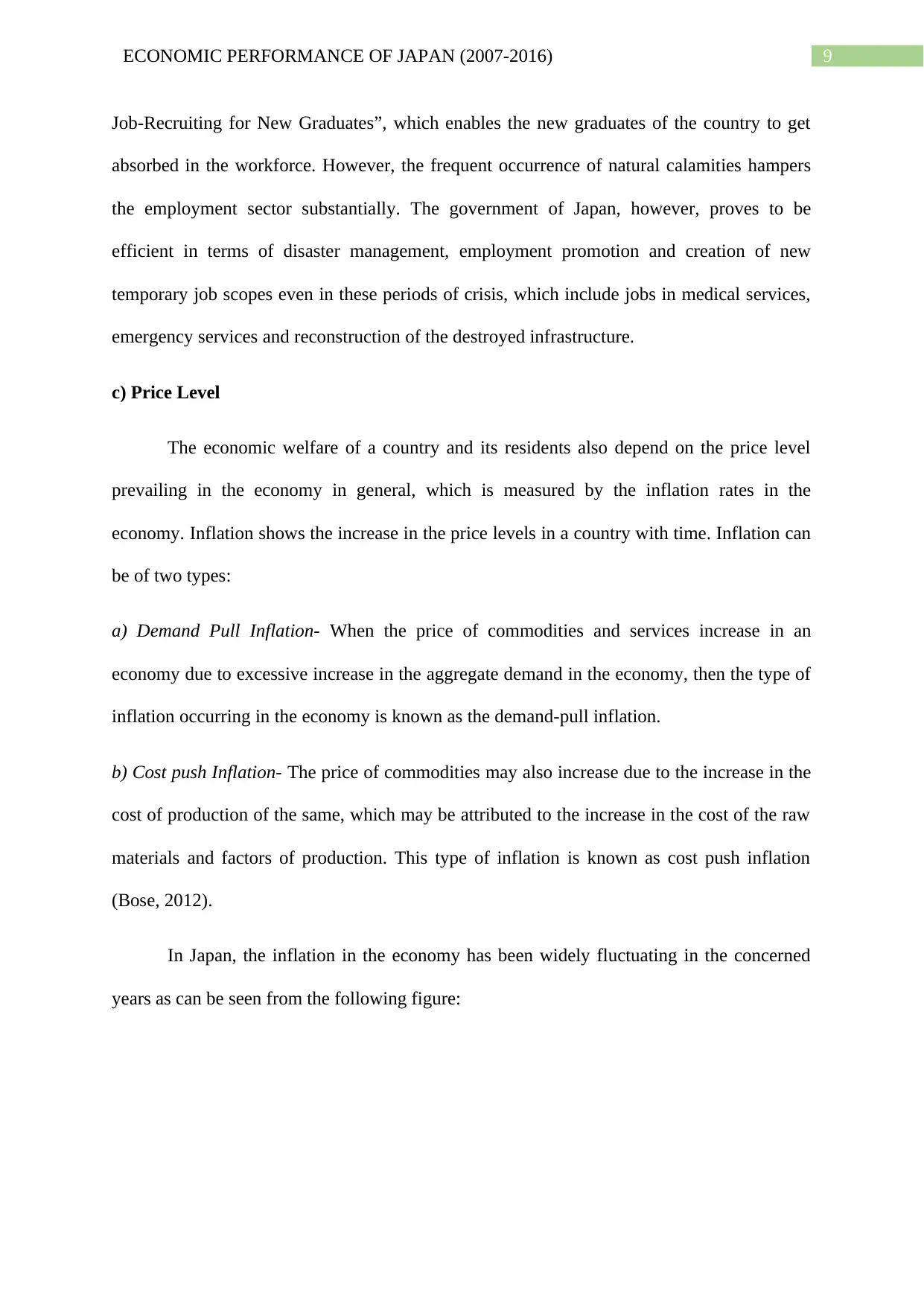
9ECONOMIC PERFORMANCE OF JAPAN (2007-2016)
Job-Recruiting for New Graduates”, which enables the new graduates of the country to get
absorbed in the workforce. However, the frequent occurrence of natural calamities hampers
the employment sector substantially. The government of Japan, however, proves to be
efficient in terms of disaster management, employment promotion and creation of new
temporary job scopes even in these periods of crisis, which include jobs in medical services,
emergency services and reconstruction of the destroyed infrastructure.
c) Price Level
The economic welfare of a country and its residents also depend on the price level
prevailing in the economy in general, which is measured by the inflation rates in the
economy. Inflation shows the increase in the price levels in a country with time. Inflation can
be of two types:
a) Demand Pull Inflation- When the price of commodities and services increase in an
economy due to excessive increase in the aggregate demand in the economy, then the type of
inflation occurring in the economy is known as the demand-pull inflation.
b) Cost push Inflation- The price of commodities may also increase due to the increase in the
cost of production of the same, which may be attributed to the increase in the cost of the raw
materials and factors of production. This type of inflation is known as cost push inflation
(Bose, 2012).
In Japan, the inflation in the economy has been widely fluctuating in the concerned
years as can be seen from the following figure:
Job-Recruiting for New Graduates”, which enables the new graduates of the country to get
absorbed in the workforce. However, the frequent occurrence of natural calamities hampers
the employment sector substantially. The government of Japan, however, proves to be
efficient in terms of disaster management, employment promotion and creation of new
temporary job scopes even in these periods of crisis, which include jobs in medical services,
emergency services and reconstruction of the destroyed infrastructure.
c) Price Level
The economic welfare of a country and its residents also depend on the price level
prevailing in the economy in general, which is measured by the inflation rates in the
economy. Inflation shows the increase in the price levels in a country with time. Inflation can
be of two types:
a) Demand Pull Inflation- When the price of commodities and services increase in an
economy due to excessive increase in the aggregate demand in the economy, then the type of
inflation occurring in the economy is known as the demand-pull inflation.
b) Cost push Inflation- The price of commodities may also increase due to the increase in the
cost of production of the same, which may be attributed to the increase in the cost of the raw
materials and factors of production. This type of inflation is known as cost push inflation
(Bose, 2012).
In Japan, the inflation in the economy has been widely fluctuating in the concerned
years as can be seen from the following figure:
Secure Best Marks with AI Grader
Need help grading? Try our AI Grader for instant feedback on your assignments.
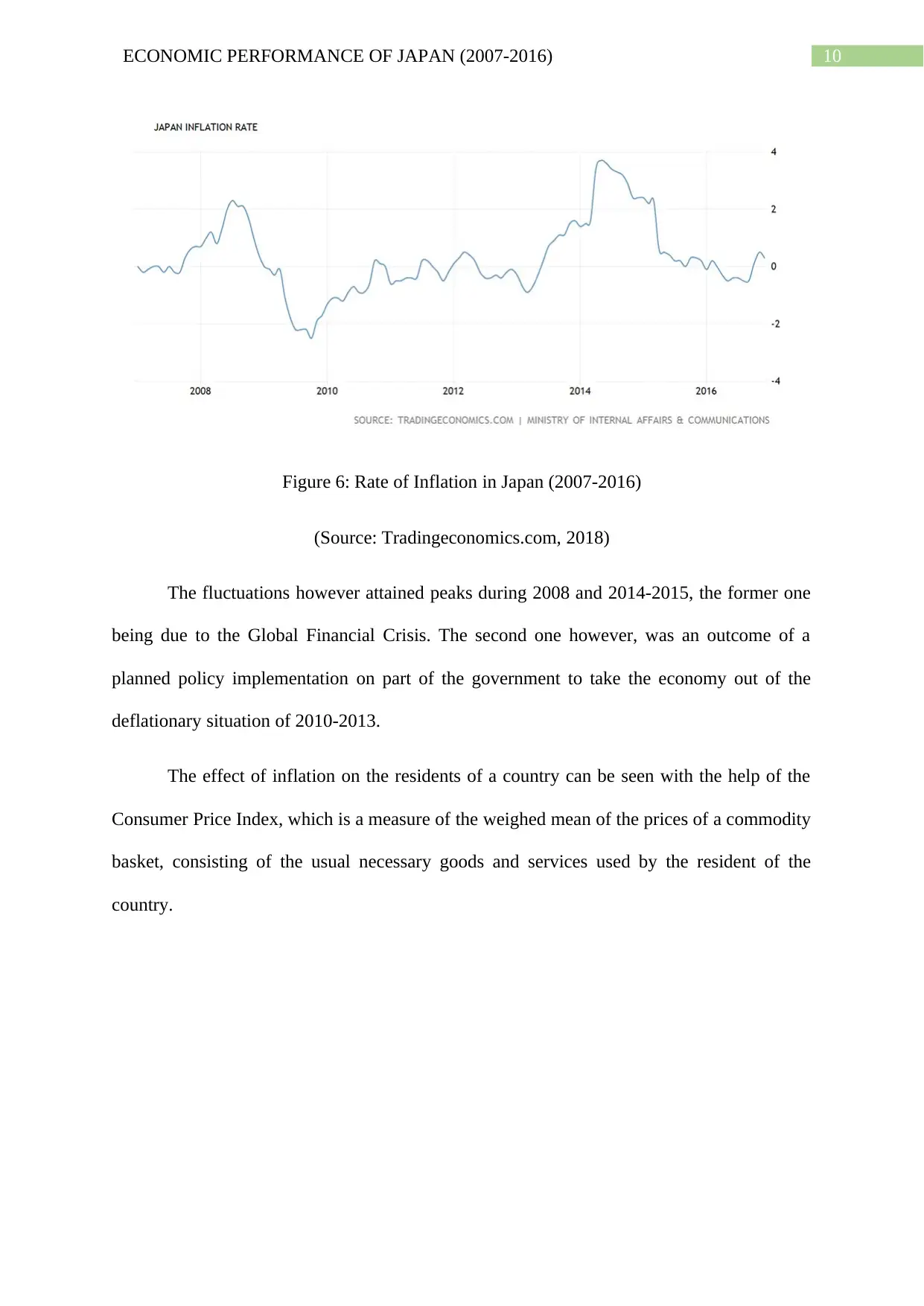
10ECONOMIC PERFORMANCE OF JAPAN (2007-2016)
Figure 6: Rate of Inflation in Japan (2007-2016)
(Source: Tradingeconomics.com, 2018)
The fluctuations however attained peaks during 2008 and 2014-2015, the former one
being due to the Global Financial Crisis. The second one however, was an outcome of a
planned policy implementation on part of the government to take the economy out of the
deflationary situation of 2010-2013.
The effect of inflation on the residents of a country can be seen with the help of the
Consumer Price Index, which is a measure of the weighed mean of the prices of a commodity
basket, consisting of the usual necessary goods and services used by the resident of the
country.
Figure 6: Rate of Inflation in Japan (2007-2016)
(Source: Tradingeconomics.com, 2018)
The fluctuations however attained peaks during 2008 and 2014-2015, the former one
being due to the Global Financial Crisis. The second one however, was an outcome of a
planned policy implementation on part of the government to take the economy out of the
deflationary situation of 2010-2013.
The effect of inflation on the residents of a country can be seen with the help of the
Consumer Price Index, which is a measure of the weighed mean of the prices of a commodity
basket, consisting of the usual necessary goods and services used by the resident of the
country.
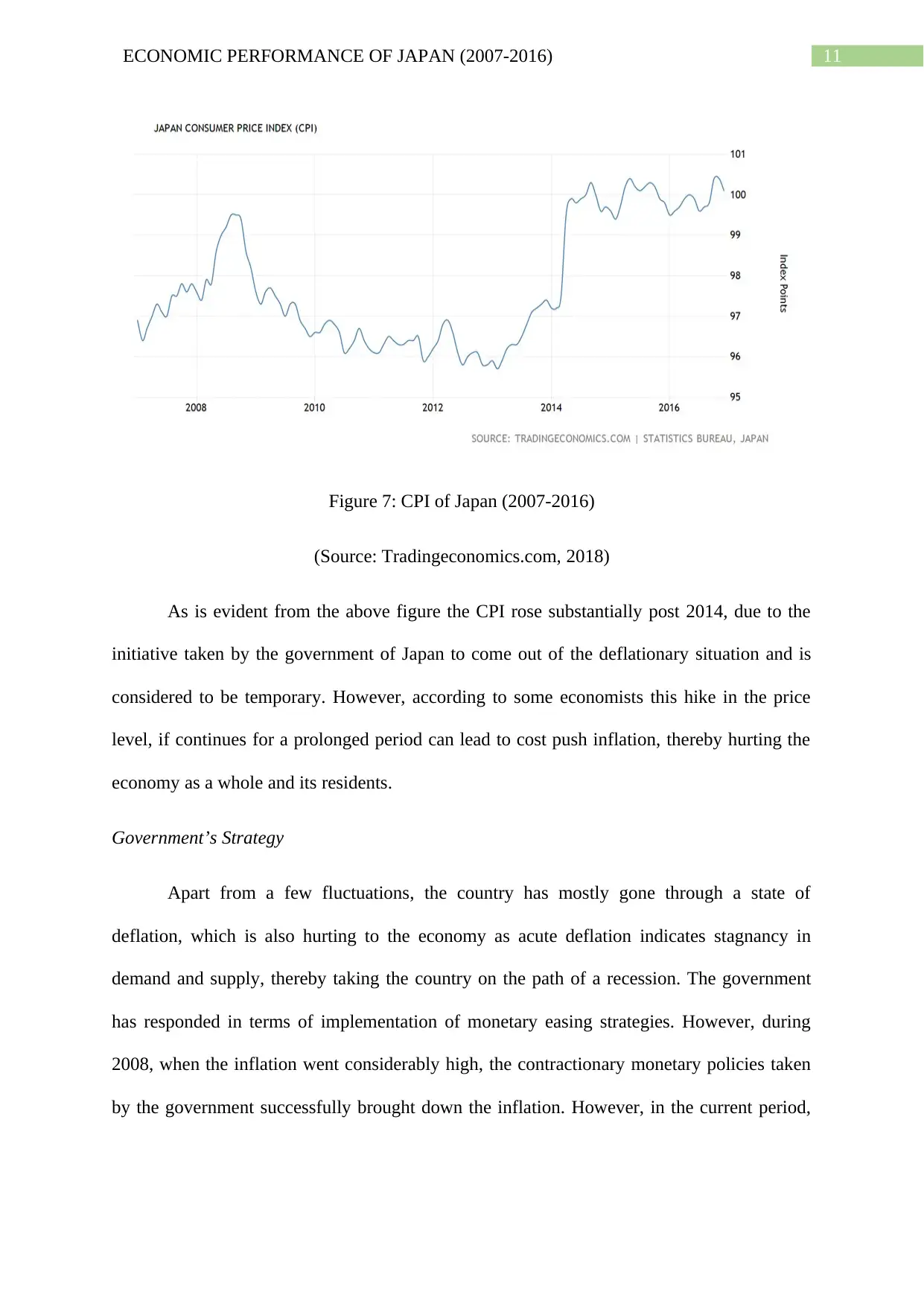
11ECONOMIC PERFORMANCE OF JAPAN (2007-2016)
Figure 7: CPI of Japan (2007-2016)
(Source: Tradingeconomics.com, 2018)
As is evident from the above figure the CPI rose substantially post 2014, due to the
initiative taken by the government of Japan to come out of the deflationary situation and is
considered to be temporary. However, according to some economists this hike in the price
level, if continues for a prolonged period can lead to cost push inflation, thereby hurting the
economy as a whole and its residents.
Government’s Strategy
Apart from a few fluctuations, the country has mostly gone through a state of
deflation, which is also hurting to the economy as acute deflation indicates stagnancy in
demand and supply, thereby taking the country on the path of a recession. The government
has responded in terms of implementation of monetary easing strategies. However, during
2008, when the inflation went considerably high, the contractionary monetary policies taken
by the government successfully brought down the inflation. However, in the current period,
Figure 7: CPI of Japan (2007-2016)
(Source: Tradingeconomics.com, 2018)
As is evident from the above figure the CPI rose substantially post 2014, due to the
initiative taken by the government of Japan to come out of the deflationary situation and is
considered to be temporary. However, according to some economists this hike in the price
level, if continues for a prolonged period can lead to cost push inflation, thereby hurting the
economy as a whole and its residents.
Government’s Strategy
Apart from a few fluctuations, the country has mostly gone through a state of
deflation, which is also hurting to the economy as acute deflation indicates stagnancy in
demand and supply, thereby taking the country on the path of a recession. The government
has responded in terms of implementation of monetary easing strategies. However, during
2008, when the inflation went considerably high, the contractionary monetary policies taken
by the government successfully brought down the inflation. However, in the current period,
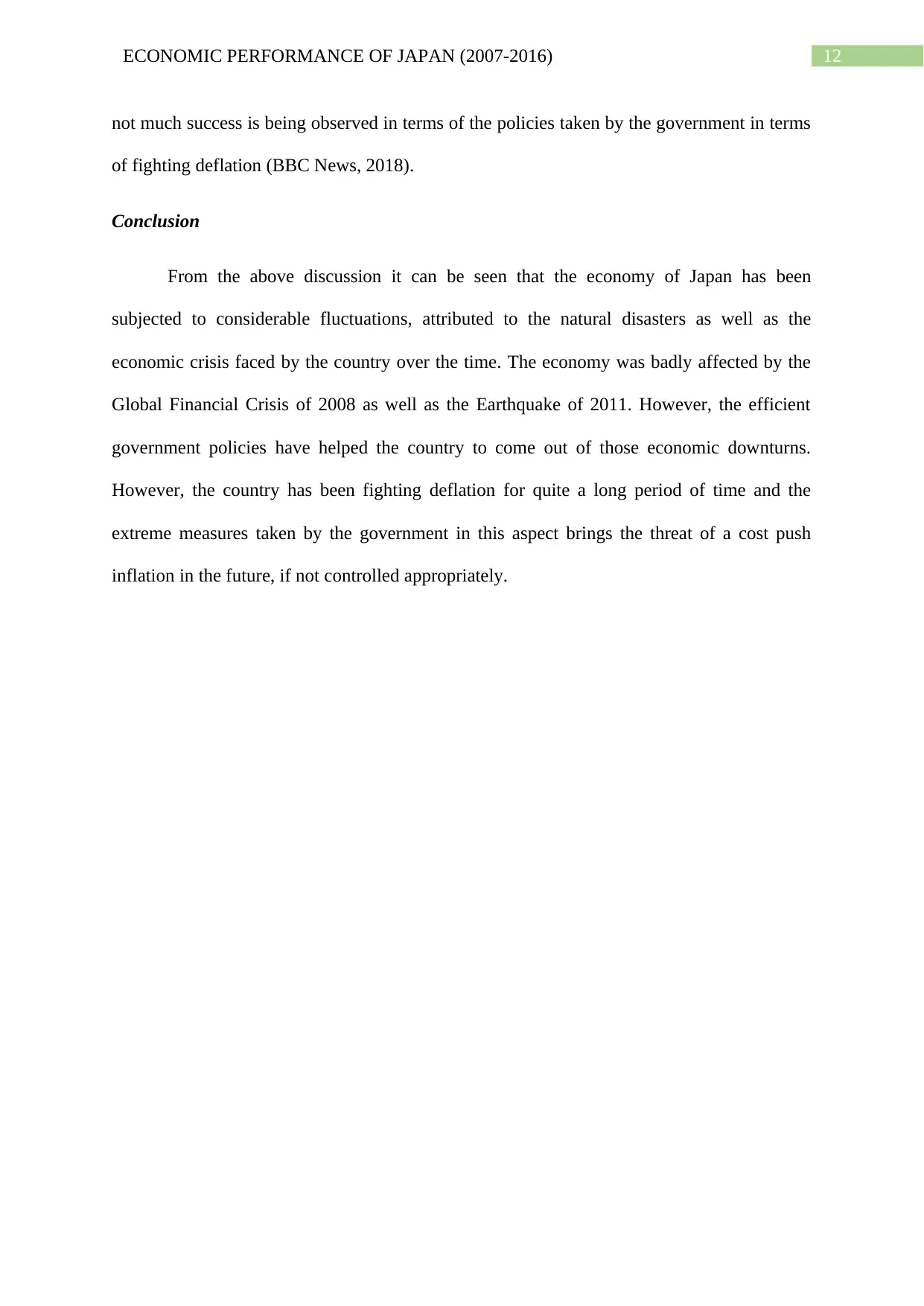
12ECONOMIC PERFORMANCE OF JAPAN (2007-2016)
not much success is being observed in terms of the policies taken by the government in terms
of fighting deflation (BBC News, 2018).
Conclusion
From the above discussion it can be seen that the economy of Japan has been
subjected to considerable fluctuations, attributed to the natural disasters as well as the
economic crisis faced by the country over the time. The economy was badly affected by the
Global Financial Crisis of 2008 as well as the Earthquake of 2011. However, the efficient
government policies have helped the country to come out of those economic downturns.
However, the country has been fighting deflation for quite a long period of time and the
extreme measures taken by the government in this aspect brings the threat of a cost push
inflation in the future, if not controlled appropriately.
not much success is being observed in terms of the policies taken by the government in terms
of fighting deflation (BBC News, 2018).
Conclusion
From the above discussion it can be seen that the economy of Japan has been
subjected to considerable fluctuations, attributed to the natural disasters as well as the
economic crisis faced by the country over the time. The economy was badly affected by the
Global Financial Crisis of 2008 as well as the Earthquake of 2011. However, the efficient
government policies have helped the country to come out of those economic downturns.
However, the country has been fighting deflation for quite a long period of time and the
extreme measures taken by the government in this aspect brings the threat of a cost push
inflation in the future, if not controlled appropriately.
Paraphrase This Document
Need a fresh take? Get an instant paraphrase of this document with our AI Paraphraser
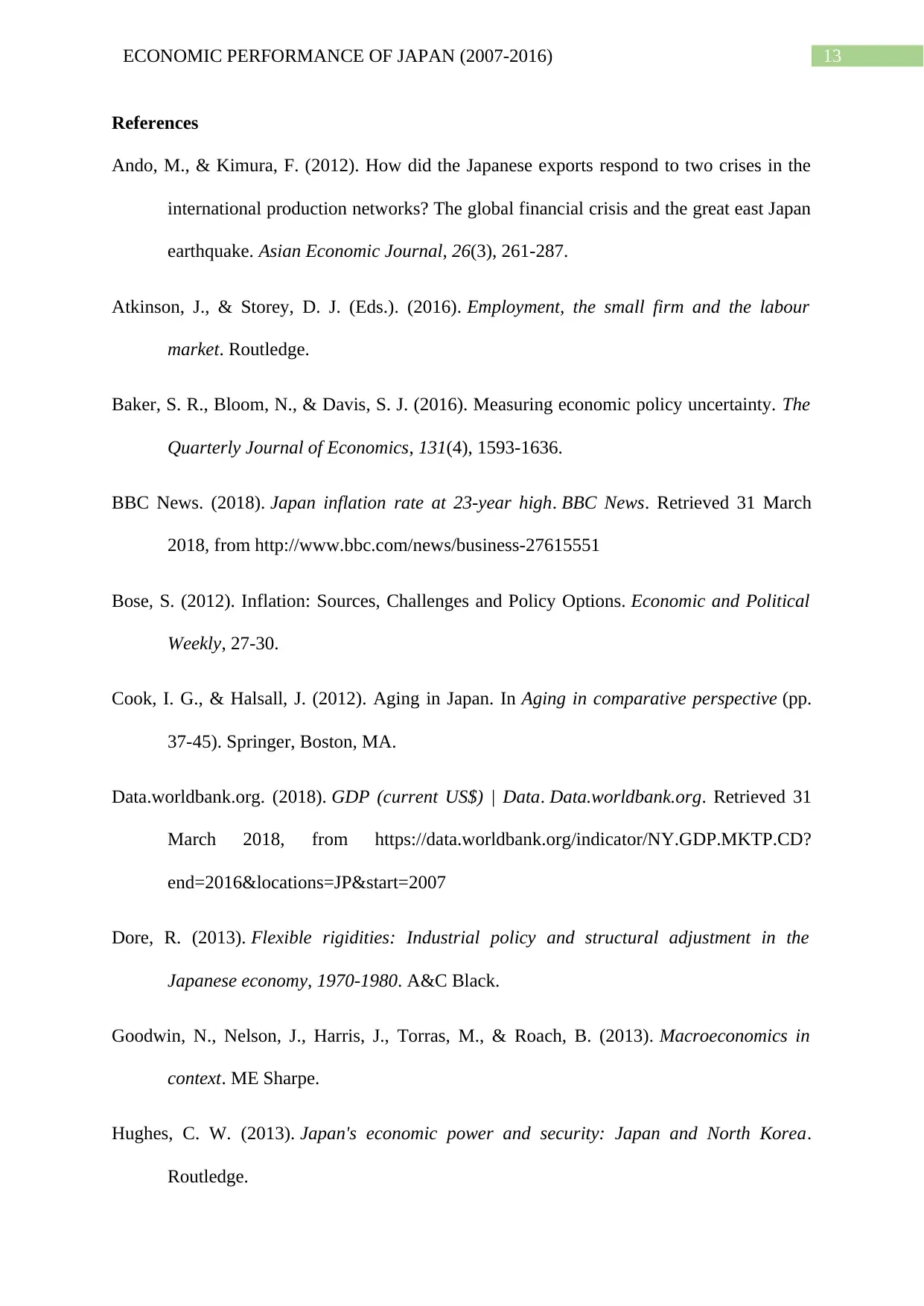
13ECONOMIC PERFORMANCE OF JAPAN (2007-2016)
References
Ando, M., & Kimura, F. (2012). How did the Japanese exports respond to two crises in the
international production networks? The global financial crisis and the great east Japan
earthquake. Asian Economic Journal, 26(3), 261-287.
Atkinson, J., & Storey, D. J. (Eds.). (2016). Employment, the small firm and the labour
market. Routledge.
Baker, S. R., Bloom, N., & Davis, S. J. (2016). Measuring economic policy uncertainty. The
Quarterly Journal of Economics, 131(4), 1593-1636.
BBC News. (2018). Japan inflation rate at 23-year high. BBC News. Retrieved 31 March
2018, from http://www.bbc.com/news/business-27615551
Bose, S. (2012). Inflation: Sources, Challenges and Policy Options. Economic and Political
Weekly, 27-30.
Cook, I. G., & Halsall, J. (2012). Aging in Japan. In Aging in comparative perspective (pp.
37-45). Springer, Boston, MA.
Data.worldbank.org. (2018). GDP (current US$) | Data. Data.worldbank.org. Retrieved 31
March 2018, from https://data.worldbank.org/indicator/NY.GDP.MKTP.CD?
end=2016&locations=JP&start=2007
Dore, R. (2013). Flexible rigidities: Industrial policy and structural adjustment in the
Japanese economy, 1970-1980. A&C Black.
Goodwin, N., Nelson, J., Harris, J., Torras, M., & Roach, B. (2013). Macroeconomics in
context. ME Sharpe.
Hughes, C. W. (2013). Japan's economic power and security: Japan and North Korea.
Routledge.
References
Ando, M., & Kimura, F. (2012). How did the Japanese exports respond to two crises in the
international production networks? The global financial crisis and the great east Japan
earthquake. Asian Economic Journal, 26(3), 261-287.
Atkinson, J., & Storey, D. J. (Eds.). (2016). Employment, the small firm and the labour
market. Routledge.
Baker, S. R., Bloom, N., & Davis, S. J. (2016). Measuring economic policy uncertainty. The
Quarterly Journal of Economics, 131(4), 1593-1636.
BBC News. (2018). Japan inflation rate at 23-year high. BBC News. Retrieved 31 March
2018, from http://www.bbc.com/news/business-27615551
Bose, S. (2012). Inflation: Sources, Challenges and Policy Options. Economic and Political
Weekly, 27-30.
Cook, I. G., & Halsall, J. (2012). Aging in Japan. In Aging in comparative perspective (pp.
37-45). Springer, Boston, MA.
Data.worldbank.org. (2018). GDP (current US$) | Data. Data.worldbank.org. Retrieved 31
March 2018, from https://data.worldbank.org/indicator/NY.GDP.MKTP.CD?
end=2016&locations=JP&start=2007
Dore, R. (2013). Flexible rigidities: Industrial policy and structural adjustment in the
Japanese economy, 1970-1980. A&C Black.
Goodwin, N., Nelson, J., Harris, J., Torras, M., & Roach, B. (2013). Macroeconomics in
context. ME Sharpe.
Hughes, C. W. (2013). Japan's economic power and security: Japan and North Korea.
Routledge.
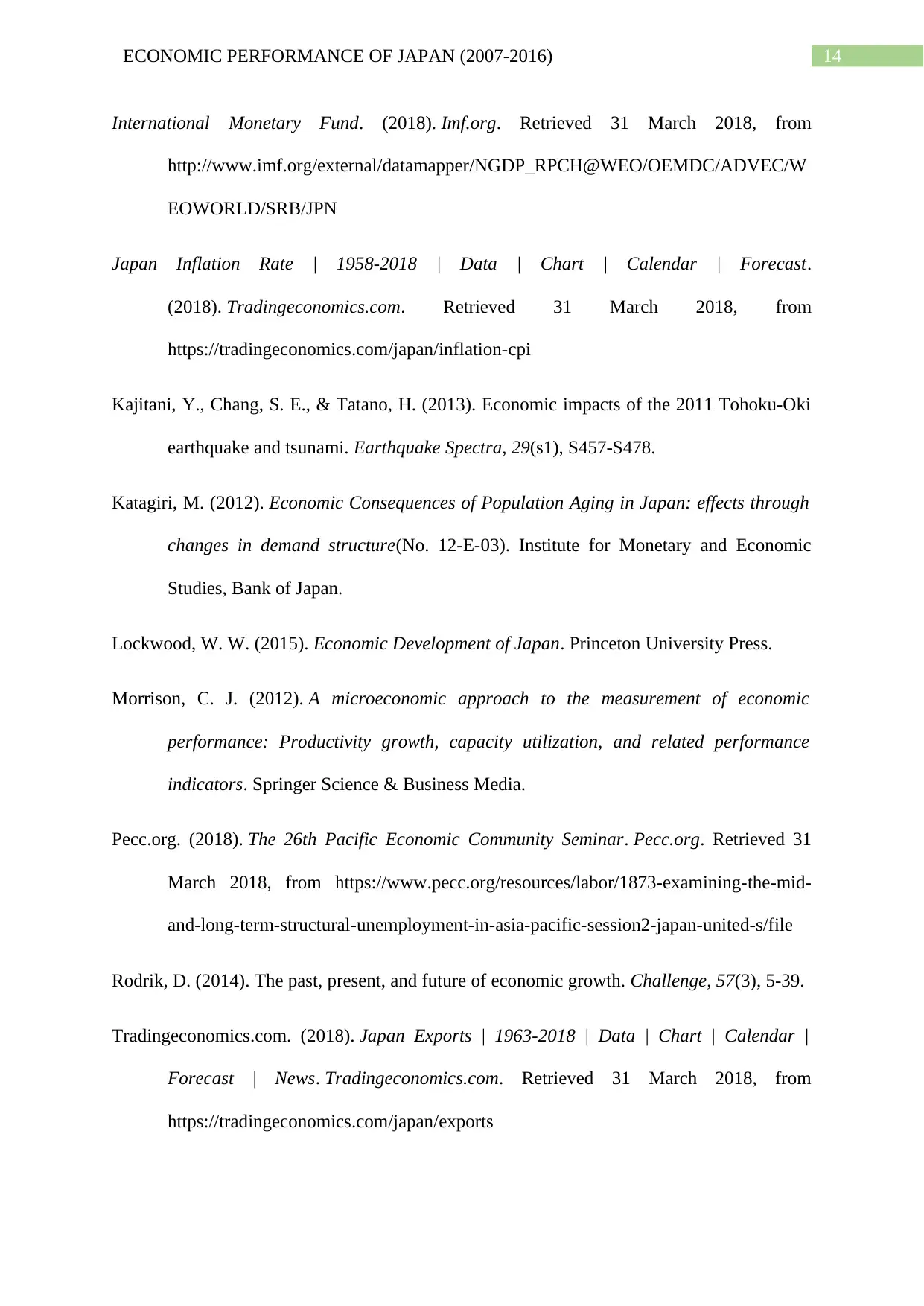
14ECONOMIC PERFORMANCE OF JAPAN (2007-2016)
International Monetary Fund. (2018). Imf.org. Retrieved 31 March 2018, from
http://www.imf.org/external/datamapper/NGDP_RPCH@WEO/OEMDC/ADVEC/W
EOWORLD/SRB/JPN
Japan Inflation Rate | 1958-2018 | Data | Chart | Calendar | Forecast.
(2018). Tradingeconomics.com. Retrieved 31 March 2018, from
https://tradingeconomics.com/japan/inflation-cpi
Kajitani, Y., Chang, S. E., & Tatano, H. (2013). Economic impacts of the 2011 Tohoku-Oki
earthquake and tsunami. Earthquake Spectra, 29(s1), S457-S478.
Katagiri, M. (2012). Economic Consequences of Population Aging in Japan: effects through
changes in demand structure(No. 12-E-03). Institute for Monetary and Economic
Studies, Bank of Japan.
Lockwood, W. W. (2015). Economic Development of Japan. Princeton University Press.
Morrison, C. J. (2012). A microeconomic approach to the measurement of economic
performance: Productivity growth, capacity utilization, and related performance
indicators. Springer Science & Business Media.
Pecc.org. (2018). The 26th Pacific Economic Community Seminar. Pecc.org. Retrieved 31
March 2018, from https://www.pecc.org/resources/labor/1873-examining-the-mid-
and-long-term-structural-unemployment-in-asia-pacific-session2-japan-united-s/file
Rodrik, D. (2014). The past, present, and future of economic growth. Challenge, 57(3), 5-39.
Tradingeconomics.com. (2018). Japan Exports | 1963-2018 | Data | Chart | Calendar |
Forecast | News. Tradingeconomics.com. Retrieved 31 March 2018, from
https://tradingeconomics.com/japan/exports
International Monetary Fund. (2018). Imf.org. Retrieved 31 March 2018, from
http://www.imf.org/external/datamapper/NGDP_RPCH@WEO/OEMDC/ADVEC/W
EOWORLD/SRB/JPN
Japan Inflation Rate | 1958-2018 | Data | Chart | Calendar | Forecast.
(2018). Tradingeconomics.com. Retrieved 31 March 2018, from
https://tradingeconomics.com/japan/inflation-cpi
Kajitani, Y., Chang, S. E., & Tatano, H. (2013). Economic impacts of the 2011 Tohoku-Oki
earthquake and tsunami. Earthquake Spectra, 29(s1), S457-S478.
Katagiri, M. (2012). Economic Consequences of Population Aging in Japan: effects through
changes in demand structure(No. 12-E-03). Institute for Monetary and Economic
Studies, Bank of Japan.
Lockwood, W. W. (2015). Economic Development of Japan. Princeton University Press.
Morrison, C. J. (2012). A microeconomic approach to the measurement of economic
performance: Productivity growth, capacity utilization, and related performance
indicators. Springer Science & Business Media.
Pecc.org. (2018). The 26th Pacific Economic Community Seminar. Pecc.org. Retrieved 31
March 2018, from https://www.pecc.org/resources/labor/1873-examining-the-mid-
and-long-term-structural-unemployment-in-asia-pacific-session2-japan-united-s/file
Rodrik, D. (2014). The past, present, and future of economic growth. Challenge, 57(3), 5-39.
Tradingeconomics.com. (2018). Japan Exports | 1963-2018 | Data | Chart | Calendar |
Forecast | News. Tradingeconomics.com. Retrieved 31 March 2018, from
https://tradingeconomics.com/japan/exports

15ECONOMIC PERFORMANCE OF JAPAN (2007-2016)
Tradingeconomics.com. (2018). Japan GDP per capita | 1960-2018 | Data | Chart |
Calendar | Forecast. Tradingeconomics.com. Retrieved 31 March 2018, from
https://tradingeconomics.com/japan/gdp-per-capita
Tradingeconomics.com. (2018). Japan Unemployment Rate | 1953-2018 | Data | Chart |
Calendar | Forecast. Tradingeconomics.com. Retrieved 31 March 2018, from
https://tradingeconomics.com/japan/unemployment-rate
Tradingeconomics.com. (2018). Japan GDP per capita | 1960-2018 | Data | Chart |
Calendar | Forecast. Tradingeconomics.com. Retrieved 31 March 2018, from
https://tradingeconomics.com/japan/gdp-per-capita
Tradingeconomics.com. (2018). Japan Unemployment Rate | 1953-2018 | Data | Chart |
Calendar | Forecast. Tradingeconomics.com. Retrieved 31 March 2018, from
https://tradingeconomics.com/japan/unemployment-rate
1 out of 16
Related Documents
Your All-in-One AI-Powered Toolkit for Academic Success.
+13062052269
info@desklib.com
Available 24*7 on WhatsApp / Email
![[object Object]](/_next/static/media/star-bottom.7253800d.svg)
Unlock your academic potential
© 2024 | Zucol Services PVT LTD | All rights reserved.





